How long do marijuana seeds last?
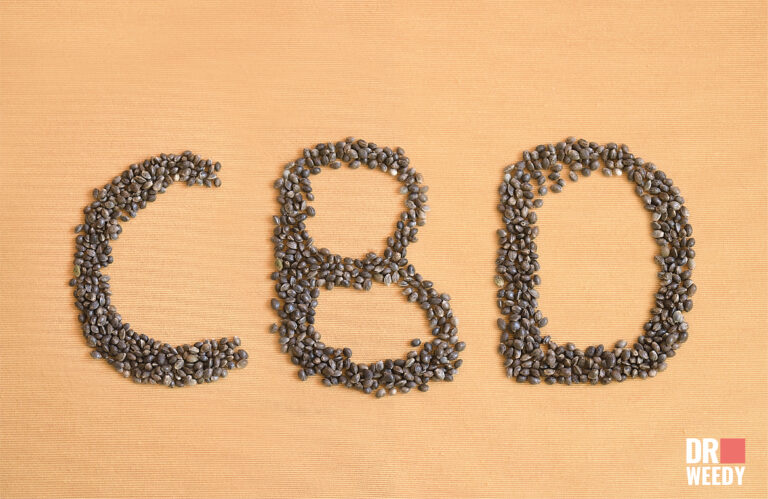
Long-Term Storage of Cannabis Seeds:
Basic Principles and Useful Tips
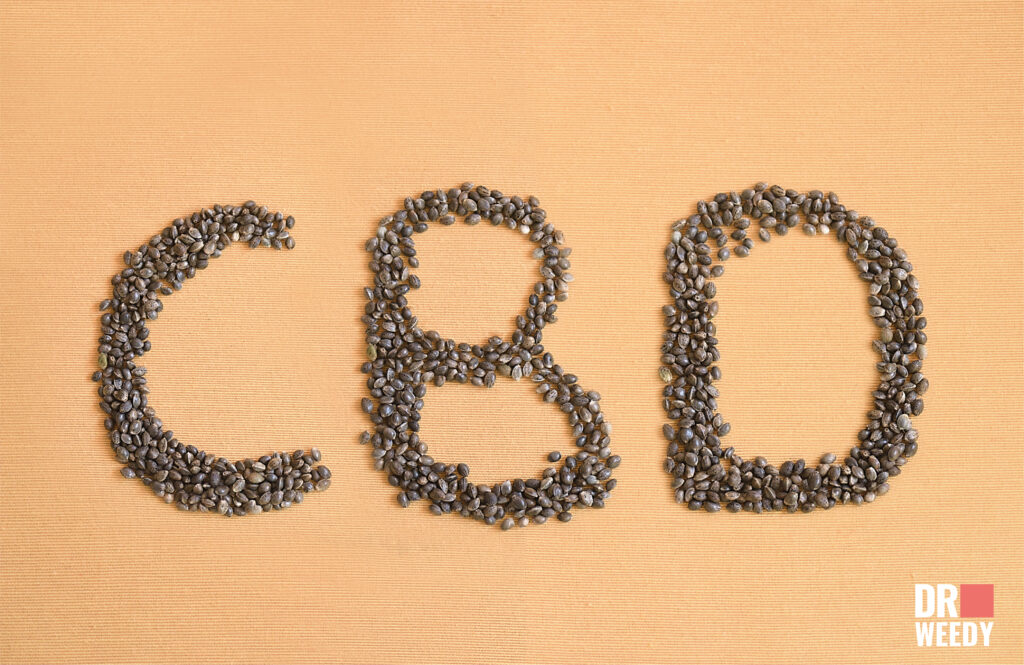
Many online weed providers offer profitable deals on buying large quantities of cannabis seeds at huge discounts. No matter how attractive these offers are from a financial point of view, you must also consider whether you will be able to store the seeds for a long time, since they do have a limited natural lifespan.
Still, there are some things you could do to preserve the seeds in a good condition for a fairly long time, which is what this article is all about. More specifically, we will address the following issues:
Can cannabis seeds go bad?What is their natural lifespan?How to tell good seeds from bad ones?What are the significant factors that affect their storage?How could the seeds be stored effectively in normal household conditions?What are the best ways to revitalize feeble marijuana seeds? |
And before we proceed with our discussion, let us start with the two most frequently asked questions concerning the storage of weed seeds.
Do Marijuana Seeds Go Bad?
Yes, they do, and they will, unless they are stored following the guidelines we provide in the sections below. However, their life depends on many factors, most of which are strongly interrelated. Moreover, these factors will operate differently, depending on the particular circumstances of your physical setting, as well as the quality of the seeds you have purchased.
In fact, even individual seeds in the same batch will have different chances to survive, despite their storage conditions and genetic factors being identical. Therefore, you should not think of what we are about to tell as cut-and-dry and unconditional principles. Which brings us to the next question.
How Long Do Marijuana Seeds Last?
First, we would like to point out that there are, in fact, two questions instead of one, namely: how long the seeds can survive, and how quickly you should sow them. The answers depend on slightly different factors, so we will treat them separately here.
As far as the natural lifespan of stored seeds is concerned, the reports we have heard and read, as well as our own experiences, differ widely, and it mainly depends on how well you manage to maintain the optimal storage conditions. We will discuss the latter in greater detail in the corresponding sections, but the table below provides very general yet realistic expectations for most seeds:
|
About six months |
Seeds exposed to fresh air, with no special storage measures applied |
|
Up to two years |
Seeds stored in airtight containers |
|
About three years |
Same as above plus protection from light |
|
Up to ten years |
All conditions at the optimal level, temperature included |
Remember, though, that just because the seeds have survived, it does not mean that they will sprout. Generally, their successful germination will depend mainly on:
- Quality of a particular strain, which is why you will have better chances with marijuana seeds purchased from a professional and reputable provider
- Age of a particular seed – the younger, the better chances, in most cases
Nevertheless, most people who grow weed at home agree that the seeds should, ideally, be planted within 18-30 months. However, more accurate timing can only be determined by visual inspection of a specific batch of seeds. For more information on the subject, see the relevant section below.
Note: if some seeds have cracked, they have no chances at all, so you may safely throw them away. |
Good Seeds vs Bad Seeds
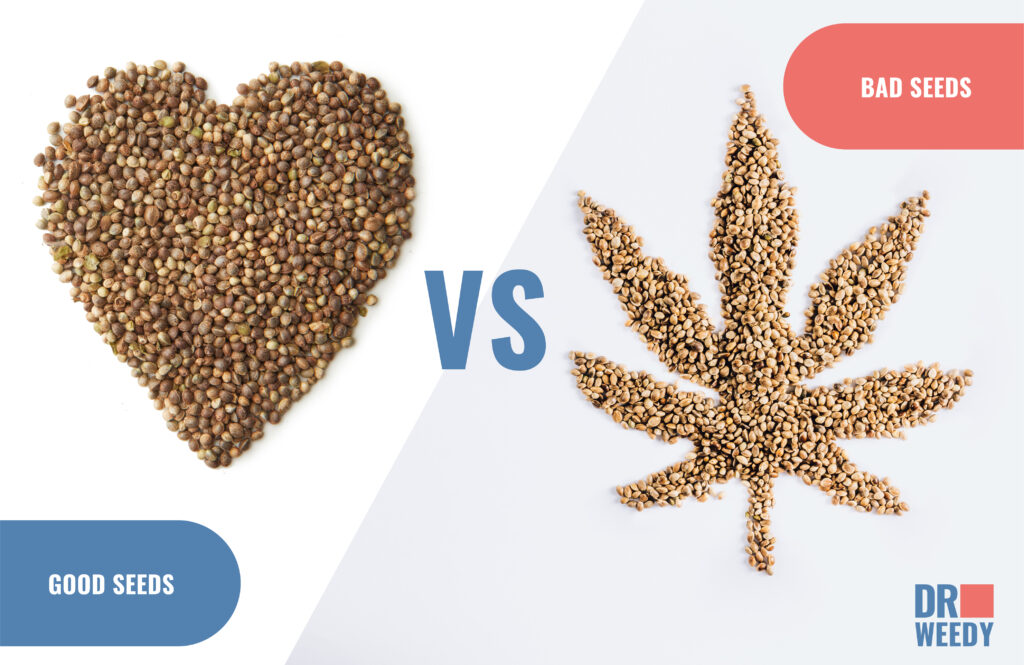
Basically, cannabis seeds go through the following three stages:
Good Yet Too Young Seeds
Whether ripe for germination or not, good seeds are:
- Firm, sturdy and pliant (that is, their surface is hard yet not too thick, and they give in slightly to a gentle squeeze with a fingernail)
- Green or brown color and shiny, but not very dark
The picture below shows an example of seeds at this stage:
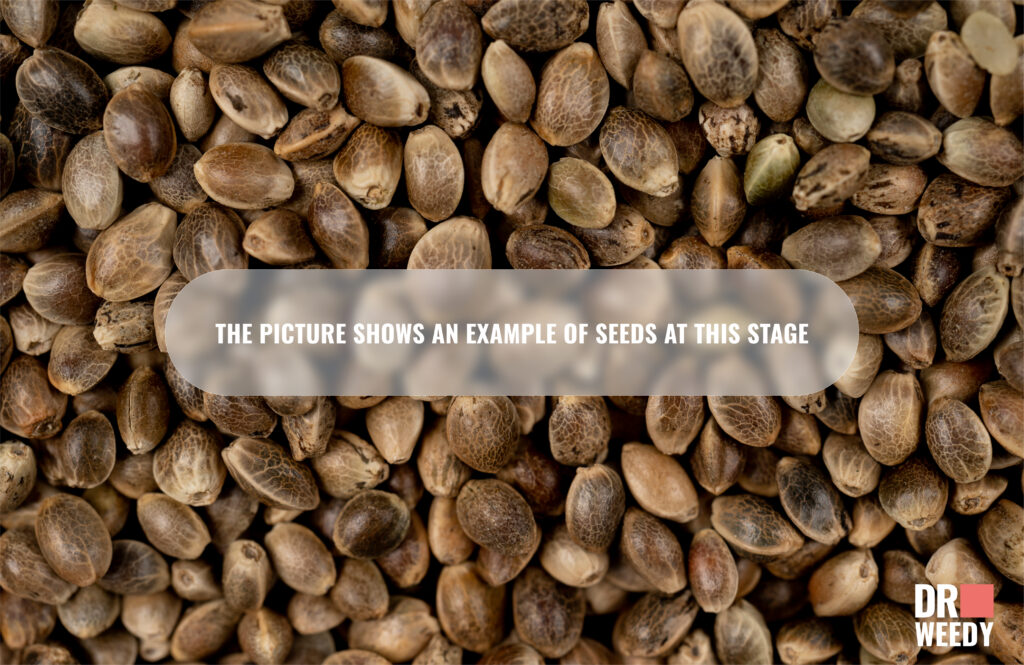
Notice that the colors are right, but the seeds are still not dark, which means that they are still too young, and germination is either unlikely or will be quite difficult to achieve. Nevertheless, these seeds can be stored easily, and they will be viable for a long time, given the right storage conditions.
Good and Ripe Seeds
At this stage, seeds are progressively more ready to germinate, and the best indicator is the shade going progressively darker. (The other conditions from the previous sections still apply, though.)
However, keep in mind that from this time on, their chances will be decreasing gradually, although they will still be high enough, depending on the storage conditions. The following picture shows an excellent example of seeds at this stage:
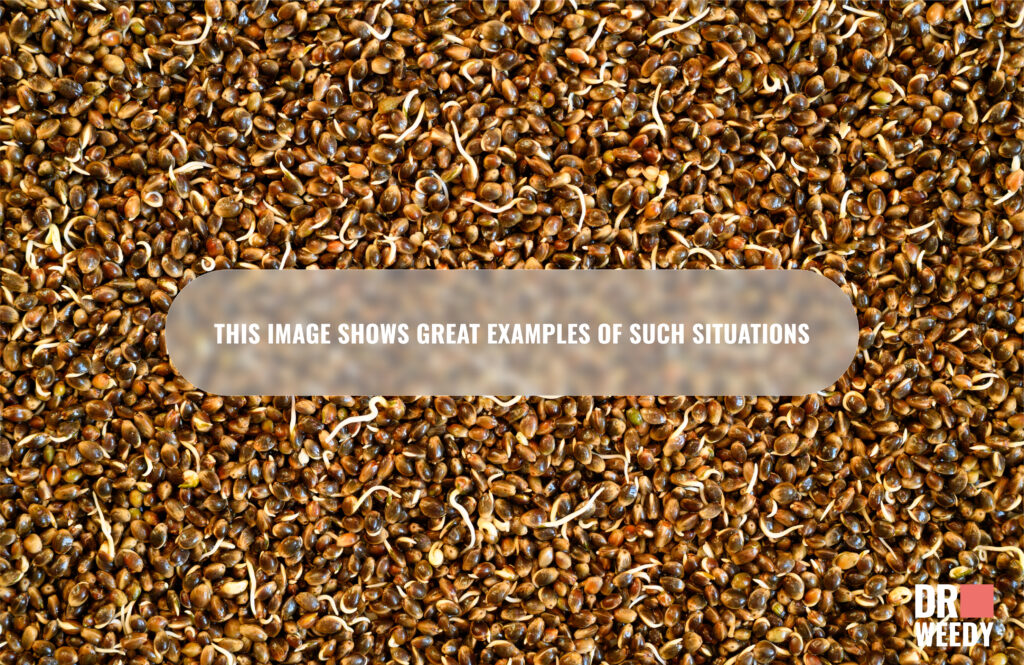
Bad Seeds
Next, a seed either becomes ripe for germination or goes bad completely, and the indications are, it begins to sprout or cracks respectively. Our next image shows good examples of both cases:
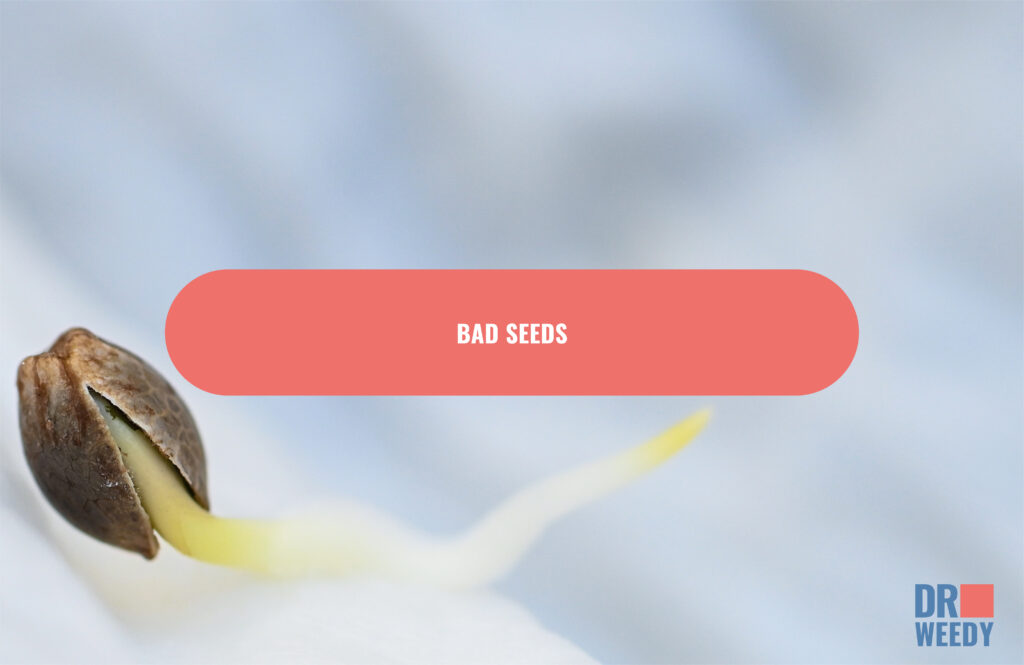
What you should do with them is separate sprouts from cracked seeds first. Next, you can throw the cracked ones away – they are no good anyway. Obviously, the sprouts should be planted at once, but if you decide not to do it for some reason, you may as well get rid of these seeds too.
Significant Factors for Effective Storage
Just like every plant under the Sun, cannabis seeds need the following for successful germination:
- Light
- Water
- Oxygen
- Heat
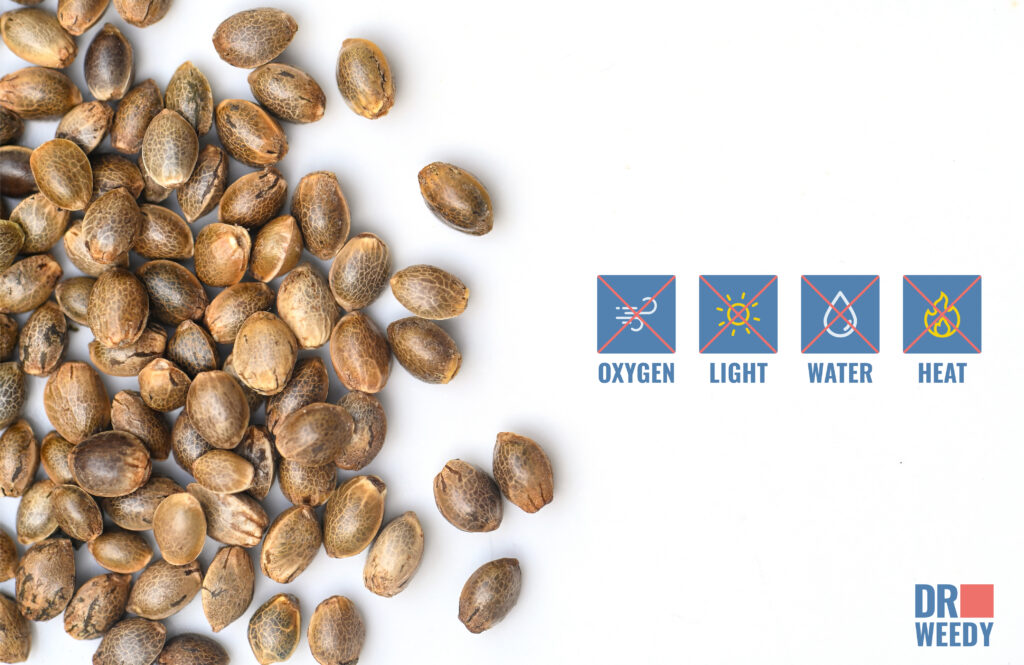
Correspondingly, effective storage of hemp seeds will boil down to eliminating these four factors as much as possible. Let us consider each factor separately, keeping in mind that they are, in fact, interdependent, of which we will give a few examples in each section.
Right Humidity
Naturally, seeds require moisture for sprouting, so you should store them in a dry place. However, there are two additional factors to consider:
The first thing to count in this case is a relative humidity: that is, how much water there is in the air compared to how much of it would be there under normal thermal conditions. The latter depends mostly on your geographic location as well as the season. Two rules apply here:
- Colder climates exhibit lower absolute humidity.
- By decreasing the temperature, you increase the RH.
That is, you should consider your area’s normal humidity too, since very low RH is no good either. Plus, you can manipulate the temperature to adjust the RH if necessary, as shown below:
|
Under 8% |
High risk of pests and drying the seeds |
|
8-10% |
Ideal for long-term storage |
|
11-16% |
Optimal for the fungi, which are bad for the seeds |
|
17- 22% |
Destroys the nutrients inside the seeds |
|
25-35% |
Ideal for short-term storage |
|
35-70% |
Facilitates germination |
|
Above 75% |
Above 75% High risk of killing the seeds within a day |
Second, there will be additional risks to account for at each RH level, such as pests and fungus, plus the extremes are equally detrimental to the seeds’ healthy development.
Note: RH of 8-10% and 25-35% seem ideal for long- and short-term storage respectively. |
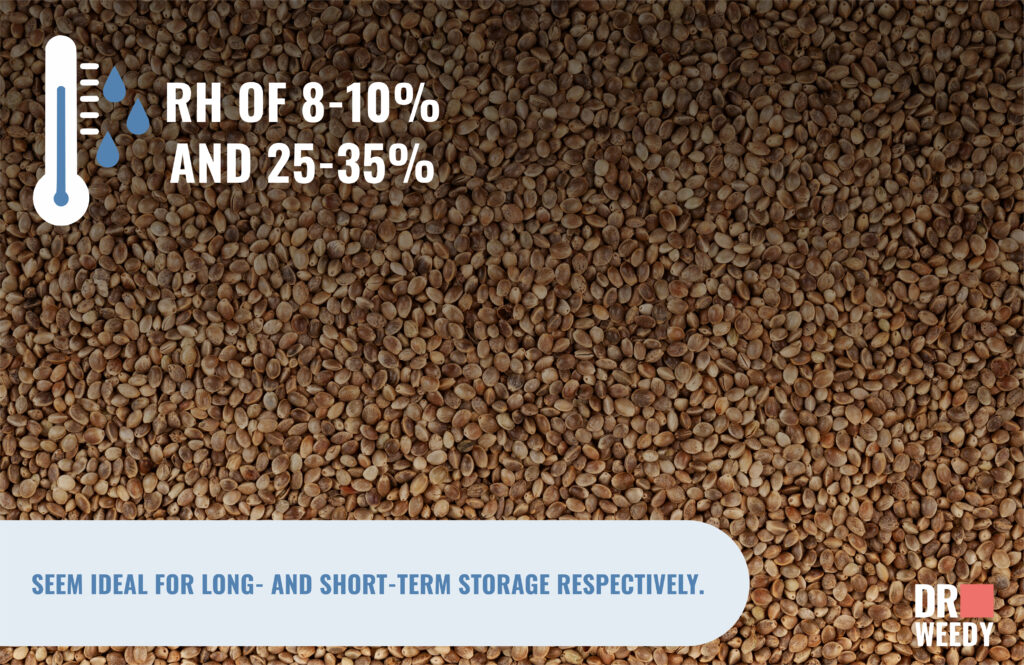
Another way to keep seeds dry is to put silica sachets into the container.
Or, if you cannot find silica, put rice instead. Do not mix it with the seeds, though, for you will need to change it occasionally.
Proper Illumination
Ideally, marijuana seeds should be kept in absolute darkness. However, nothing activates the germination mechanisms better than sudden contrast in lighting and temperature. Yet, you need some light to check on the seeds occasionally. Therefore, it is best to keep them in a dimly lit room.
Correct Temperature
The right storage temperature is closely interrelated with RH, and the extremes have an equally bad effect on the seeds. Furthermore, if you choose to keep them in the fridge, opening the door frequently will cause regular fluctuations, which is no good either. Therefore, the ideal solution is to store the seeds in a special cooler box or cellar.
Note: 41-46 °F seem ideal for long-term storage. |
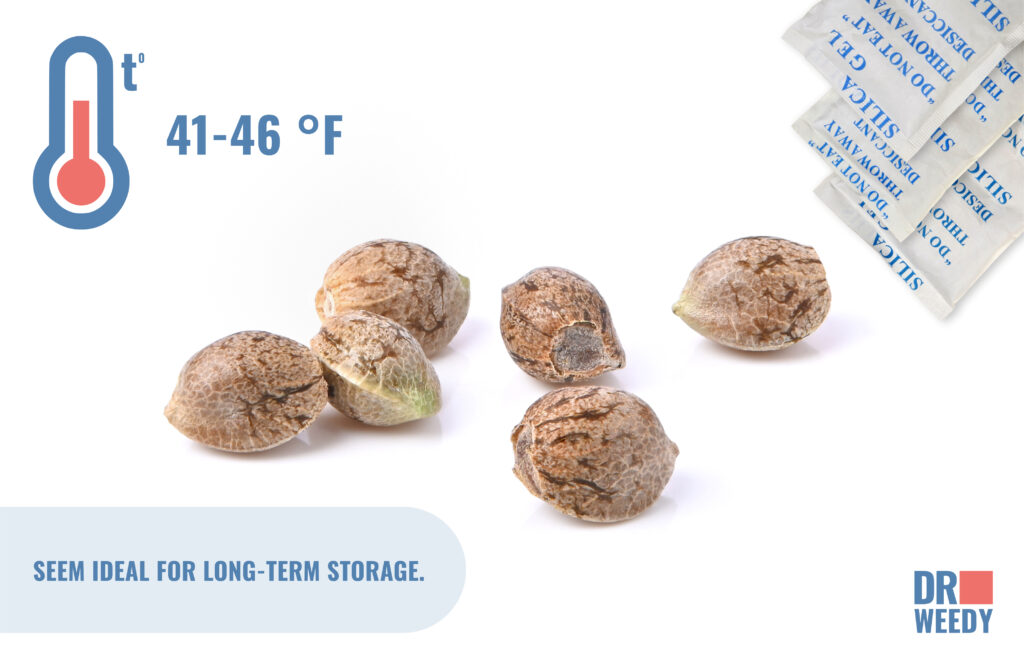
Air Exposure
It is equally important to prevent any contact of the seeds with oxygen. Vacuum-sealed containers are the best for the purpose, but if you cannot find them, use airtight ones, at least.
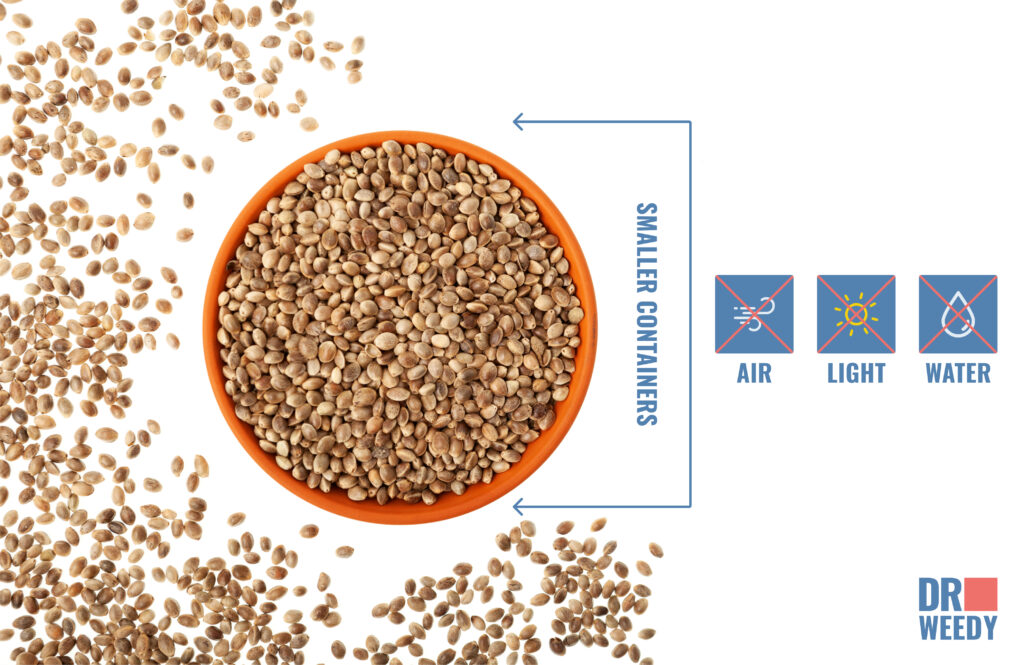
Note: it is better to keep the seeds in smaller containers so that you do not have to expose them to air, water and light very often. |
Revitalizing Feeble Seeds
Finally, when you are ready to sow the seeds years later, you may find that their shells have become too thick and hard for successful germination. The usual practice is to rub the seeds with sandpaper in order to soften them.
Admittedly, it is a delicate and exhausting task, but there is another way to achieve the same effect more easily:
- Put the seeds into water of 70-73 °F.
- Add a few oz of hydrogen peroxide to it.
- Leave the seeds there for a 1-1.5 days.
- Voilà, the seeds are ready to proceed on their own.
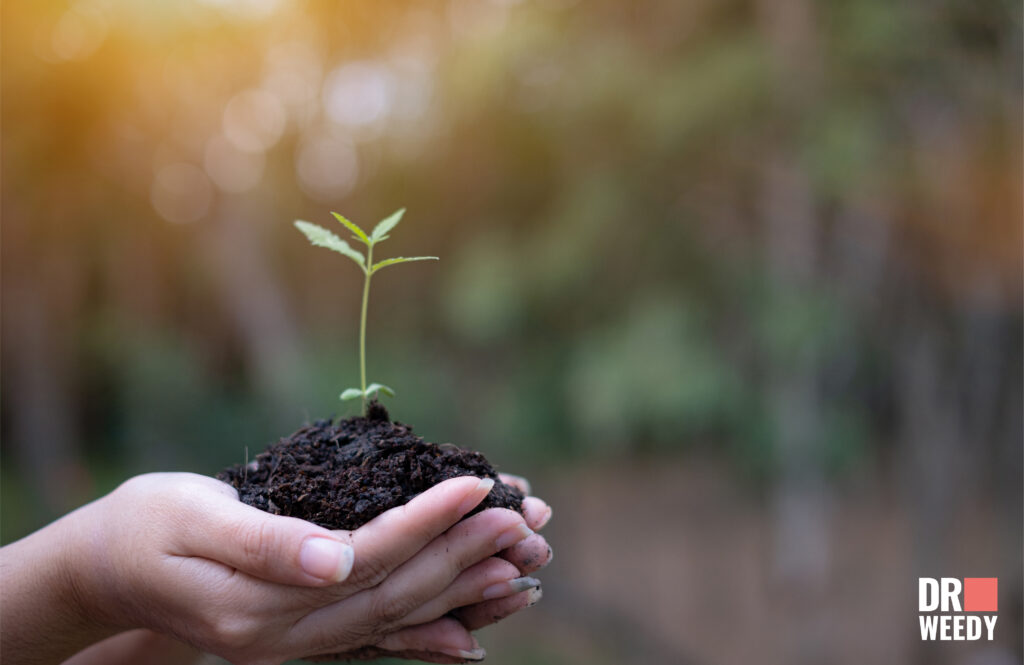
Conclusion
Organic processes are unpredictable, and the incredible occurs regularly. The chances that your marijuana seeds will germinate are never zero or 100, and any prediction of the lifespan of a particular seed is always tentative.
Still, following our recommendations will increase the likelihood immensely. And if you failed to store your cannabis seeds properly, give them a chance anyway – there may well be a few survivors in the batch!
























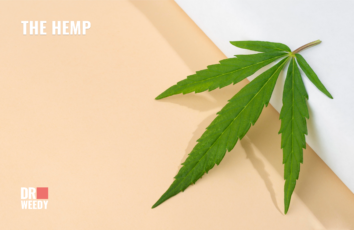

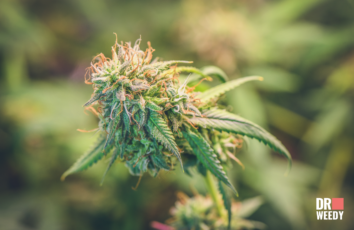
very helpful info thanks so much.
wow!